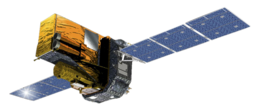
Back إنتغرال Arabic INTEGRAL (satelit) BS INTEGRAL (nau espacial) Catalan INTEGRAL Czech Integral (Satellit) German INTEGRAL Spanish انتگرال (ماهواره) Persian INTEGRAL Finnish International Gamma-Ray Astrophysics Laboratory French INTEGRAL (satélite) Galician
 Artist's impression of the INTEGRAL spacecraft | |||||||||||||||
| Mission type | Astronomy | ||||||||||||||
|---|---|---|---|---|---|---|---|---|---|---|---|---|---|---|---|
| Operator | ESA / RKA / NASA | ||||||||||||||
| COSPAR ID | 2002-048A | ||||||||||||||
| SATCAT no. | 27540 | ||||||||||||||
| Website | sci | ||||||||||||||
| Mission duration | 21 years, 7 months and 16 days elapsed | ||||||||||||||
| Spacecraft properties | |||||||||||||||
| Manufacturer | Alenia Spazio | ||||||||||||||
| Launch mass | ~ 4,000 kg (8,800 lb) | ||||||||||||||
| Dry mass | ~ 3,450 kg (7,610 lb) | ||||||||||||||
| Payload mass | ~ 2,000 kg (4,400 lb) | ||||||||||||||
| Dimensions | 5 m × 2.8 m × 3.2 m (16.4 ft × 9.2 ft × 10.5 ft) | ||||||||||||||
| Start of mission | |||||||||||||||
| Launch date | 17 October 2002, 01:33 UTC[1] | ||||||||||||||
| Rocket | Proton-K Blok-DM2 | ||||||||||||||
| Launch site | Baikonur 200/39 | ||||||||||||||
| Contractor | Roscosmos | ||||||||||||||
| Orbital parameters | |||||||||||||||
| Reference system | Geocentric | ||||||||||||||
| Regime | Highly elliptical | ||||||||||||||
| Semi-major axis | 81,116 kilometres (50,403 mi)[2] | ||||||||||||||
| Perigee altitude | 1,911 kilometres (1,187 mi)[2] | ||||||||||||||
| Apogee altitude | 147,563 kilometres (91,691 mi)[2] | ||||||||||||||
| Inclination | 68.0 degrees[2] | ||||||||||||||
| Period | 3,832.0 minutes[2] | ||||||||||||||
| Epoch | 17 October 2021, 05:57:43 UTC[2] | ||||||||||||||
| Main telescope | |||||||||||||||
| Type | Coded mask telescope | ||||||||||||||
| Diameter | 3.7 metres (12 ft) | ||||||||||||||
| Focal length | ~ 4 metres (13 ft) | ||||||||||||||
| Collecting area | 500 cm2 (78 sq in) (SPI, JEM-X) 3,100 cm2 (480 sq in) (IBIS) | ||||||||||||||
| Wavelengths | 15 keV to 10 MeV (main) 3 to 35 keV (JEM-X) 500 to 580 nm (OMC) | ||||||||||||||
| |||||||||||||||
 ESA astrophysics insignia for INTEGRAL | |||||||||||||||

Earth · INTEGRAL
The INTErnational Gamma-Ray Astrophysics Laboratory (INTEGRAL) is a space telescope for observing gamma rays of energies up to 8 MeV. It was launched by the European Space Agency (ESA) into Earth orbit in 2002, and is designed to provide imaging and spectroscopy of cosmic sources. In the MeV energy range, it is the most sensitive gamma ray observatory in space.[3] It is sensitive to higher energy photons than X-ray instruments such as NuSTAR, the Neil Gehrels Swift Observatory, XMM-Newton, and lower than other gamma-ray instruments such Fermi and HESS.
Photons in INTEGRAL's energy range are emitted by relativistic and supra-thermal[clarification needed] particles in violent sources, radioactivity from unstable isotopes produced during nucleosynthesis, X-ray binaries, and astronomical transients of all types, including gamma-ray bursts. The spacecraft's instruments have very wide fields of view, which is particularly useful for detecting gamma-ray emission from transient sources as they can continuously monitor large parts of the sky.
INTEGRAL is an ESA mission with additional contributions from European member states including Italy, France, Germany, and Spain. Cooperation partners are the Russian Space Agency with IKI (military CP Comand Punkt KW) and NASA.
As of June 2023, INTEGRAL continues to operate despite the loss of its thrusters through the use of its reaction wheels and solar radiation pressure.[4][5]
- ^ "NASA - NSSDC - Spacecraft Details". NASA. Retrieved 2 February 2015.
- ^ a b c d e f "INTEGRAL Satellite details 2002-048A NORAD 27540". N2YO. 17 October 2021. Retrieved 19 October 2021.
- ^ Teegarden, B. J.; Sturner, S. J. (April 1999). "INTEGRAL Observations of Gamma-Ray Bursts". American Astronomical Society, HEAD Meeting #4, #17.01; Bulletin of the American Astronomical Society. 31: 717. Bibcode:1999HEAD....4.1701T.
- ^ Cite error: The named reference
esa-20211018was invoked but never defined (see the help page). - ^ Cite error: The named reference
integral-updateswas invoked but never defined (see the help page).
© MMXXIII Rich X Search. We shall prevail. All rights reserved. Rich X Search